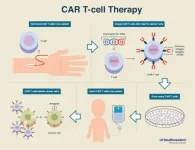(Press-News.org) LA JOLLA--(March 8, 2021) Deep learning is a potential tool for scientists to glean more detail from low-resolution images in microscopy, but it's often difficult to gather enough baseline data to train computers in the process. Now, a new method developed by scientists at the Salk Institute could make the technology more accessible--by taking high-resolution images, and artificially degrading them.
The new tool, which the researchers call a "crappifier," could make it significantly easier for scientists to get detailed images of cells or cellular structures that have previously been difficult to observe because they require low-light conditions, such as mitochondria, which can divide when stressed by the lasers used to illuminate them. It could also help democratize microscopy, allowing scientists to capture high-resolution images even if they don't have access to powerful microscopes. The findings were published March 8, 2021, in the journal Nature Methods.
"We invest millions of dollars in these microscopes, and we're still struggling to push the limits of what they can do," says Uri Manor, director of the Waitt Advanced Biophotonics Core Facility at Salk. "That's the problem we were trying to solve with deep learning."
Deep learning is a type of artificial intelligence (AI) in which computer algorithms learn and improve by studying examples. To use deep learning to improve microscope images--either by improving the resolution (sharpness) or reducing background "noise"--the system would need to be shown many examples of both high- and low-resolution images. That's a problem, because capturing perfectly identical microscopy images in two separate exposures can be difficult and expensive. It's especially challenging when imaging living cells that might be moving around during the process.
That's where the crappifier comes in. According to Manor, the method takes high-quality images and computationally degrades them, so that they look something like the lowest low-resolution images the team would acquire.
Manor's team showed high-resolution images and their degraded counterparts to the deep learning software, called Point-Scanning Super-Resolution, or PSSR. After studying the degraded images, the system was able to learn how to improve images that were naturally poor quality.
That's significant because, in the past, computer systems that learned on artificially-degraded data still struggled when presented with raw data from the real world.
"We tried a bunch of different degradation methods, and we found one that actually works," Manor says. "You can train a model on your artificially-generated data, and it actually works on real-world data."
"Using our method, people can benefit from this powerful, deep learning technology without investing a lot of time or resources," says Linjing Fang, image analysis specialist at the Waitt Advanced Biophotonics Core Facility, and lead author on the paper. "You can use pre-existing high-quality data, degrade it, and train a model to improve the quality of a lower-resolution image."
The team showed that PSSR works in both electron microscopy and with fluorescence live cell images--two situations where it can be extraordinarily difficult or impossible to obtain the duplicate high- and low-resolution images needed to train AI systems. While the study demonstrated the method on images of brain tissue, Manor hopes it could be applied to other systems of the body in the future.
He also hopes it could someday be used to make high-resolution microscopic imaging more widely accessible. Currently, the most powerful microscopes in the world can cost upwards of a million dollars, because of the precision engineering required to create high-resolution images. "One of our visions for the future is to be able to start replacing some of those expensive components with deep learning," Manor says, "So we could start making microscopes cheaper and more accessible."
INFORMATION:
Other authors on the study are Sammy Weiser Novak, Cara R. Schiavon, Tong Zhang and Melissa Wu of the Salk Institute; Fred Monroe of the Wicklow AI Medical Research Initiative; Lindsey Kirk and Kristen Harris of the University of Texas at Austin; Seungyoon B. Yu and Gulcin Pekkurnaz of the University of California San Diego; Kyle Kastner of the Université de Montréal, Yoshiyuki Kubota of the National Institute for Physiological Sciences, Okazaki, Japan; Zhao Zhang of the University of Texas at Austin, and Alaa Abdel Latif, Zijun Lin,, Andrew Shaw and Jeremy Howard of the University of San Francisco.
The research was supported by the National Science Foundation, the Chan-Zuckerberg Initiative, the Waitt Foundation, the National Cancer Institute, the National Institute on Deafness and Other Communication Disorders, the National Institute of Mental Health, the Wicklow AI Medical Research Initiative, the Parkinson's Foundation, the National Institute of Health, and the Japan Society for the Promotion of Science.
About the Salk Institute for Biological Studies:
Every cure has a starting point. The Salk Institute embodies Jonas Salk's mission to dare to make dreams into reality. Its internationally renowned and award-winning scientists explore the very foundations of life, seeking new understandings in neuroscience, genetics, immunology, plant biology and more. The Institute is an independent nonprofit organization and architectural landmark: small by choice, intimate by nature and fearless in the face of any challenge. Be it cancer or Alzheimer's, aging or diabetes, Salk is where cures begin. Learn more at: salk.edu.
What The Study Did: Researchers assessed the number of hospital admissions for noncommunicable diseases (abnormal tissue growths, metabolic diseases, cardiovascular diseases and musculoskeletal diseases) in São Paulo, Brazil, between January and June last year compared with the corresponding periods in the previous three years.
Authors: Fernando Adami, Ph.D., of the Laboratório de Epidemiologia e Análise de Dados, Centro Universitário Saúde ABC in São Paulo, Brazil, is the corresponding author.
To access the embargoed study: Visit our For The Media website at this link https://media.jamanetwork.com/
(doi:10.1001/jamanetworkopen.2021.0799)
Editor's Note: Please ...
Menlo Park, Calif. -- Scientists have taken a major step forward in harnessing machine learning to accelerate the design for better batteries: Instead of using it just to speed up scientific analysis by looking for patterns in data, as researchers generally do, they combined it with knowledge gained from experiments and equations guided by physics to discover and explain a process that shortens the lifetimes of fast-charging lithium-ion batteries.
It was the first time this approach, known as "scientific machine learning," has been applied to battery cycling, said Will Chueh, an associate ...
Hamilton, ON (March 8, 2021) - Many parents know the struggle of having to make children with pneumonia finish the usual 10-day course in antibiotics despite the child feeling better after a few days of medication.
New research from McMaster University has proven that a five-day course of high-dose amoxicillin will do just as well for children six months to 10 years old with common pneumonia.
"Several studies have proven that adults with pneumonia do fine with short courses of antibiotics, and now we have proved a short course of antibiotics also works for children," said Dr. Jeffrey ...
A study from North Carolina State University found outdoor play and nature-based activities helped buffer some of the negative mental health impacts of the COVID-19 pandemic for adolescents.
Researchers said the findings, published in the International Journal of Environmental Research and Public Health, point to outdoor play and nature-based activities as a tool to help teenagers cope with major stressors like the COVID-19 pandemic, as well as future natural disasters and other global stressors. Researchers also underscore the mental health implications of restricting outdoor recreation opportunities for adolescents, and the need to increase ...
DALLAS - March 8, 2021 - A new type of CAR T-cell therapy more than triples the expected length of remission for multiple myeloma patients who have relapsed several times, according to an international clinical trial with UT Southwestern as the lead enrolling site.
Results of the trial, published recently in the New England Journal of Medicine, were significantly better than those seen with other therapies available to heavily relapsed and refractory myeloma patients who had already received the three main classes of treatment. Nearly three-quarters of the patients had at least a partial response to the therapy. About a third achieved a complete remission, with the disappearance of all traces of cancer.
Median time without the disease worsening was 8.8 months with this new ...
A woman grips her purse tightly as you approach. A store manager follows you because you look "suspicious." You enter a high-end restaurant, and the staff assume you're applying for a job. You're called on in work meetings only when they're talking about diversity.
The indignities and humiliations Black men -- even those who have "made it" -- regularly endure have long been seen as part and parcel of life in the United States among the Black community, a sort of "Black tax" that takes a heavy toll on physical and mental health.
Now, a new UCLA-led study reveals these "hidden costs" of being Black in America. ...
FAYETTEVILLE, Ark. - Moral outrage is an attractive behavior, particularly to people seeking long-term relationships, according to a new paper by researchers including a University of Arkansas psychologist.
The work indicates that people who displayed moral outrage were considered more benevolent and trustworthy than a control person not displaying outrage, and therefore more likely to possess other prosocial behaviors that would benefit a long-term relationship. There was a catch, however: Researchers found that people had to take action to address the moral wrong in question and not just talk about ...
Aurora, Colo. (March 8, 2021) - In a new study published in JAMA Pediatrics, researchers at Children's Hospital Colorado (Children's Colorado) have found that tetrahydrocannabinol (THC), the psychoactive component of marijuana, stays in breast milk for up to six weeks, further supporting the recommendations of the American Academy of Pediatrics, the American College of Obstetricians and Gynecologists and the Academy of Breastfeeding Medicine to abstain from marijuana use during pregnancy and while a mother is breastfeeding. This is the first study examining THC in breastmilk and plasma among women with known marijuana use in pregnancy since a 1982 study in the New England Journal of Medicine.
"With the increasing utilization of marijuana in society as a ...
Research from Queen Mary University of London has concluded that there is convincing evidence that type 2 diabetes is associated with an increased risk of Parkinson's disease. The same study found that there was also evidence that type 2 diabetes may contribute to faster disease progression in patients who already have Parkinson's.
Treating people with drugs already available for type 2 diabetes may reduce the risk and slow the progression of Parkinson's. Screening for and early treatment of type 2 diabetes in patients with Parkinson's may be advisable.
Previous systematic reviews and meta-analyses have produced conflicting results around ...
Key Takeaways:
Machine learning offers more accurate targeting in mobile advertising.
Behavioral targeting is more effective than contextual targeting.
There is a possibility for self-regulation because too much behavioral targeting can reduce competition and hurt ad networks' revenues.
CATONSVILLE, MD, March 8, 2021 - It's a common assumption among marketers that if you can customize any form of marketing, particularly mobile advertising, you'll get better results. With this in mind, mobile marketing relies significantly on user tracking data ...


